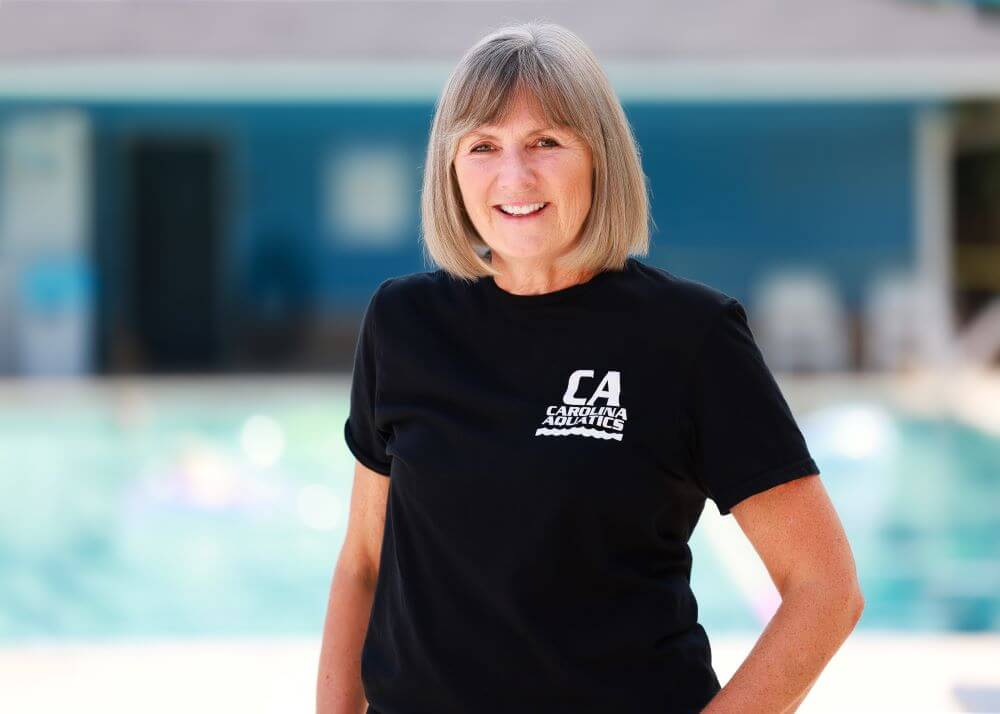A Q&A With Pam Swander, CEO and Head Coach at Carolina Aquatics Swim Club

A Q&A With Pam Swander, CEO and Head Coach at Carolina Aquatics Swim Club
Swimming became Pam Swander’s athletic outlet after childhood scoliosis surgery. Since then, she has built an aquatic life working with and learning from some of the nation’s most respected coaches.
Pam Swander
CEO and Head Coach
Carolina Aquatics Swim Club
Lexington, South Carolina
- Arizona State, B.A., secondary education, 1986
- CEO and head coach, Carolina Aquatics Swim Club, 2021-present
- Assistant coach, University of South Carolina, 2018-21
- Head coach, South Carolina Swim Club, 2016-18
- Regional manager, SwimMAC Carolina, 2010-16
- Associate women’s head coach, Indiana University, 2005-10
- Assistant Coach, Clemson University, 2004-05
- Senior coach and Swim America director, Washington Townships Swimming Club, 2001-04
- Assistant senior and age group coach, Indy Dolphins, 2000-01
- Head age group coach, Center Grove Aquatics Club, 1997-2000
- Head coach, Yorktown (Ind.) Swim Club, 1987-97
- Director, USA Swimming Select Camp, 2006-07
- Vice chair hospitality, USA Swimming Olympic Trials Committee, 2000
- Indiana delegate, USA Swimming national convention
- Chairman, nominating committee, South Carolina LSC
- Member, USA Swimming nominating committee
- Inducted into the Delaware County (Muncie, Ind.) Athletic Hall of Fame, 2011
SWIMMING WORLD: Three decades-plus as a coach. Were you a swimmer yourself?
COACH PAM SWANDER: Yes, summer league and high school. I started swimming competitively after scoliosis surgery. I have a 12-inch stainless steel Herrington rod implant to straighten my spine. With swimming, I had no physical limits. It was how I earned my high school PE credit.
SW: Any mentors for you as a swimmer?
PS: My first summer league coach ignited my passion for the sport by making it fun to work hard.
SW: As a coach?
PS: Mark Hesse, Chris Ip, Ray Looze and David Marsh.
SW: Training philosophy. What is it?
PS: As a club coach, I believe in a strong technical foundation, IM training, kick-driven activity and race savvy.
SW: Do you see yourself as a proponent of volume, race pace or of something else?
PS: Technique first…then a bit of it all. I will cycle through appropriate volume, race pace and speed at different times in the season.
SW: You have coached at every level from summer league to college. What is the biggest difference in coaching these various groups?
PS: The biggest difference is swimmer perspective and how they prioritize the sport.
SW: How have you shifted your focus with different groups in the actual training…and in relating to your swimmers?
PS: In my current role with CA (Carolina Aquatics), I am coaching the newest team members. This requires an abundance of patience, a ton of education for both swimmers and parents, and honing my practices so the young ones understand. For example, I can’t give instructions like, “Leave on top.” I’ve been reminded that there are a lot of unwritten cultural rules in our sport that need to be taught: Things like, “Don’t save up for a big finish on a set,” or “Don’t speed up to pass then slow down.”
SW: You coached two children (son, Kevin, and daughter, Laura) who were CSCAA All-Americans and American record holders. In coaching them, is there anything you would have done differently?
SW: Professionally, I started coaching before I had my children, so I was always a swim coach who became a mom. At the pool, I was coach, and at home, I was mom. The early years of my career were spent coaching all the programs in my small hometown. My kids participated in those programs. I grew up with my kids in the sport. When they went to college, I pursued college coaching. Chris Ip hired me at Clemson University and mentored me through my first college coaching gig. I am very grateful for all the experiences I’ve had in swimming, and I wouldn’t change a thing.
SW: How did each preceding job prepare you for the next position?
PS: Each step ALWAYS made sense for my family and challenged me to grow and learn. The step from college to SwimMAC was just a new challenge and good for my family. My experience at IU (particularly the women’s team), along with my desire to join Coach David Marsh at SwimMAC in Charlotte, just made sense for me.
SW: You are recognized as a pioneer in how you integrate resistance into your weekly training plan. How does that work?
PS: The inspiration for these types of sets came from my IU days and were modified to be interesting and challenging morning training sets for the club swimmers. The sets create competition among the athletes. They are motivational because the swimmers track their performance from week to week
Basically, they are a combination of resistance with parachutes and fast swimming. I organize the lanes so that the swimmers are racing and competing in each round. Such a set evolves throughout the cycle until it peaks, and then tapers during championship season.
* * *
Michael J. Stott is an ASCA Level 5 coach, golf and swimming writer. His critically acclaimed coming-of-age golf novel, “Too Much Loft,” is in its third printing, and is available from store.Bookbaby.com, Amazon, B&N and distributors worldwide.



